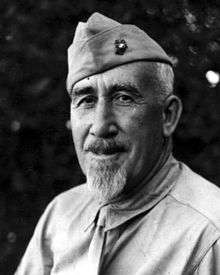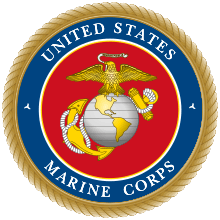Lou Diamond
Leland "Lou" Diamond (May 30, 1890 – September 20, 1951) was an American serviceman who served in the U.S. Marine Corps.
Lou Diamond | |
|---|---|
 Leland 'Lou' Diamond | |
| Birth name | Leland Diamond |
| Nickname(s) |
|
| Born | May 30, 1890 Bedford, Ohio |
| Died | September 20, 1951 (aged 61) Great Lakes, Illinois |
| Allegiance | |
| Service/ | |
| Years of service |
|
| Rank | |
| Battles/wars |
|
| Awards | See decorations |
Early years
Leland Diamond was born in Bedford, Ohio. His parents, Herbert Caleb Diamond (1864–1932) and Mima Ellenor (1866–1921), were Canadians from Belleville, Ontario. His father was the youngest of the famed Diamond Brothers of the North-West Mounted Police (NWMP), who served in the Red Deer District of Alberta in the 1880s. He is descended from the Hudson River Valley Algonquin-Mohican Diamond family of the pre-American-Revolution era. His ancestors were United Empire Loyalists John Diamond (1759–1845) and Christiana Loyst (1765–1842), from Dutchess County, New York, who fled to Fredericksburgh, Ontario after the Revolution.
The “Master Gunny” was a member and frequent visitor of the Toledo, Ohio Jewish Serviceman's USO Club sponsored by the National Jewish Welfare Board (NJWB) in 1943 as indicated by his registration card coded as a NON-JEW with a hole punched in the top left hand corner. Diamond was a practicing Episcopalian as noted in the notes of journalist Marc Parrott who was present at Master Gunny Diamond's Episcopalian funeral services.
He enlisted in the Marine Corps in Detroit, Michigan, July 25, 1917 at the age of 27, listing as his former occupation "railroad switchman". He was assigned Marine Service Number 98912.
World War I
As a corporal in January 1918, he shipped out from Philadelphia aboard the USS Von Steuben bound for Brest, France. He saw action with the famous 6th Marine Regiment in the battles at Chateau Thierry, Belleau Wood, the Aisne-Marne, St. Mihiel and the Meuse-Argonne. Promoted to the grade of Sergeant, he marched to the Rhine with the Army of Occupation. At war's end, "Mr. Leatherneck" returned to America, and received an honorable discharge.
Inter-war period
Railroading, and civilian life in general, did not suit him, and on September 23, 1921, Diamond re-enlisted.
"Mr. Marine" itched for more action and he soon got it in Shanghai, with Company M, 3rd Battalion, 4th Marine Regiment. But the Sino-Japanese controversy, in Diamond's opinion, was "not much of a war," and on June 10, 1933, he returned to the United States, disembarking from the USS Henderson (AP-1) at Mare Island, California. By then he was a gunnery sergeant.
Diamond returned to Shanghai with his old outfit, the 4th Marines, ten months later; was transferred to the 2nd Marines in December 1934; and returned to the States in February 1937. Two years after his promotion to master gunnery sergeant on July 10, 1939, he was assigned to the Depot of Supplies at Philadelphia to help design a new infantry pack.
World War II
Following the Japanese attack at Pearl Harbor, Diamond shipped out to Guadalcanal with Company H, 2nd Battalion, 5th Marines, 1st Marine Division, arriving at the beaches August 7, 1942. He was then 52 years old.
Though not a "spit-and-polish" Marine, Diamond proved himself an expert with both 60- and 81-mm mortars, his accurate fire being credited as the turning point of many battles on Guadalcanal. Among the many fables concerning his Guadalcanal service is the tale that he lobbed a mortar shell down the smoke stack of an off-shore Japanese cruiser. It is considered a fact, however, that he drove the cruiser from the bay with his harassing "near-misses."[1]
General A.A. Vandegrift, Commander of the 1st Marine Division, and later Commandant of the Marine Corps, wrote a letter of commendation that states in part:
The Commanding General takes the greatest pleasure in commending you for the outstanding performance of duty on Tulagi and Guadalcanal, British Solomon Islands, during the occupation of those Islands by the first Marine Division. As Master Gunnery Sergeant of Company “H”, Second Battalion, Fifth Marines, you performed your duties in an outstanding manner throughout the above period. On several occasions, the well-directed and well-timed fire of the Mortar Platoon under your charge was a deciding factor in halting an enemy attack and enabling friendly troops to advance against enemy positions. You deserve the highest credit in connection with maintaining the morale of the men of the Second Battalion, Fifth Marines. You were at all times cheerful, energetic and encouraging, and never more so than during those periods when the going was toughest. You brought the benefit of your long service experience and mature judgment to the younger less-experienced men of your unit and helped them in every way possible. To every man in your company, you were a counselor, an arbiter of disputes, and an ideal Marine. Your matchless loyalty and love of the Marine Corps and all it stands for are known to hundreds of officers and men of this Division and will serve as an inspiration to them on all the battlefields on which this Division may on the future be engaged. The Commandant, U.S. Marine Corps has been furnished a copy of this letter, with a request that it be made a part of your official record.
After two months on Guadalcanal, physical disabilities dictated his evacuation by air against his wishes. He was moved to the New Hebrides and later to a hospital in New Zealand, where he somehow acquired orders to board a supply ship for New Caledonia. There a friend ordered him back to Guadalcanal – the supposed location of his old outfit. Upon his arrival, however, Diamond discovered that the 1st Marine Division had shipped out to Australia, a distance of over 1,500 miles (2,400 km). Diamond made the trip, without orders, by bumming rides on planes, ships and trains.
But Diamond was destined not to see any more combat. On July 1, 1943, he disembarked from the USS Hermitage (AP-54) at San Pedro, California, and twelve days later was made an instructor at the MCRD Parris Island, South Carolina. He was transferred to Camp Lejeune on June 15, 1945, and joined the 5th Training Battalion with the same duties.
Retirement
Diamond retired on November 23, 1945, and returned to his home in Toledo, Ohio.
Death
His death at the Great Lakes, Illinois, Naval Training Center Hospital, September 20, 1951, was followed by a funeral, with military honors, at Sylvania, Ohio. Journalist Marc Parrott notes that Diamond's funeral service was Episcopalian.[2] He was laid to rest at Toledo Memorial Park in Sylvania.
Legacy
Actor Ward Bond portrayed Diamond in an episode of the television series Cavalcade of America entitled "The Marine Who Lived 200 years." It aired on June 1, 1955; a copy has been located at the Marine Corps Museum.
The Filipino-American actor Lou Diamond Phillips was named after him by his father, a Marine Corps C-130 Crew Chief.[3]
Although Diamond is sometimes referred to as "highly decorated", his only personal decoration was the Secretary of the Navy Commendation Ribbon, which later became the Navy Commendation Medal. Diamond's other awards include:
- the Presidential Unit Citation awarded to the First Marine Division for Guadalcanal.
- the Marine Corps Good Conduct Medal, eight awards, representing 24 years service.
- the World War I Victory Medal, with four campaign stars (Aisne-Marne, St. Mihiel, Meuse-Argonne, and Defensive Sector), for service with the 6th Marine Regiment.
- the Army of Occupation of Germany Medal, for service in the Rhineland in 1919.
- the Yangtze Service Medal, for service in China in 1927–32.
- the Marine Corps Expeditionary Medal, for service in China 1934–37.
- the American Defense Service Medal, for service 1939–1941.
- the American Campaign Medal, for service in the United States 1943–1945.
- the Asiatic-Pacific Campaign Medal, with two campaign stars (Guadalcanal-Tulagi Landings and Capture and Defense of Guadalcanal), for service with the 2nd Battalion 5th Marine Regiment.
- the World War II Victory Medal.
Diamond was also entitled to the French Fourragère (Croix de Guerre 1914–1918) as a personal award, since he had participated in earning it with the 6th Marines.
Decorations
| 1st row | Navy Commendation Medal | Presidential Unit Citation | Marine Corps Good Conduct Medal | |||||||||
|---|---|---|---|---|---|---|---|---|---|---|---|---|
| 2nd row | Marine Corps Expeditionary Medal | Yangtze Service Medal | World War I Victory Medal with 5 battle clasps |
Army of Occupation of Germany Medal | ||||||||
| 3rd row | American Defense Service Medal | American Campaign Medal | Asiatic-Pacific Campaign Medal | World War II Victory Medal | ||||||||
See also
- List of historically important U.S. Marines
References
- "Master Gunnery Sergeant Leland Diamond, USMC (Deceased)". United States Marine Corps, History Division. Archived from the original on 2015-09-23. Retrieved 2019-04-14.
- Parrott, Marc, Hazard: Marines on Mission, Doubleday & Co. Inc., New York, 1962
- "Lou Diamond Phillips". Oldenburg International Film Festival. Retrieved June 27, 2019.
Lou was born at the Subic Bay Naval Station in the Philippines – where his father, and American Naval Officer was stationed – and named after WW2 legend & hero Leland 'Lou' Diamond.
External links
- "Master Gunnery Sergeant Leland Diamond". Who's Who in Marine Corps History. United States Marine Corps.
- "Find-A-Grave". Leland "Lou" Diamond
